New South Wales
Art Gallery NSW
Working arrangements
The Art Gallery of NSW reopened to the public in June and continues to forge ahead with a combination of rotating gallery and remote workdays. The paintings conservation team has settled into a strange new routine of working on- and off-site to reduce the numbers working in the lab on any one day. More recently we have had the full team working together on Tuesdays and have enjoyed the non-virtual discussions, albeit at socially distanced spacing. The frames conservation department continues to strike a balance between working from home and doing treatment on-site, which so has far has been achievable with the completion of larger frame treatments freeing up space for smaller works. The paper conservation team is fortunate to have a large lab space to accommodate three people, whilst mount cutting has its own room, and has combined working from home and in the lab, preparing for upcoming exhibitions and loans.
Professional news
We all congratulate Grace for receiving a George Alexander Foundation fellowship through the International Specialised Skills Institute (ISSI). Grace will be researching the Conservation Trailblazer Apprenticeship program in the United Kingdom and we all look forward to seeing the results of her research in the coming months. Well done Grace!
Exhibitions
The Streeton retrospective, an exhibition of works of renowned Australian artist Arthur Streeton, is going ahead, although delayed from original dates due to pandemic disruptions, giving us that little bit more time to finish treatment work. Streeton was an active environmentalist and it is interesting to see how his concerns about the landscape are still so prevalent today. The show will feature over 150 works, some of which have not been exhibited in over 100 years, and will be carried over to next year – with the treatment of many works finalised and others close to completion.
Analiese is completing treatment of a group of watercolours for the exhibition. Simon Ives has been busy removing discoloured varnish from Streeton’s The Gloucester Buckets, and a slow, meditative two hours filming of this project is available to view.
Grace Barrand has been busy completing the last of other major treatments for Streeton. Genevieve Tobin completed the momentous treatment of the frame for The Gloucester Buckets for the exhibition. The treatment involved the removal of two layers of extensive bronze overpaint, removal of degrading gilding, retouching (thanks to a novel albeit ingenious use of an airbrush) and the imitation of faux finishes using non-traditional gilding and glazing techniques. The frame has now been reunited with its beautifully restored slip thanks to Tom Langlands. Gen recently joined the objects team part time and has been working with Melanie Barrett on data entry for the collaborative research project Polymuse plastics in museum collections.
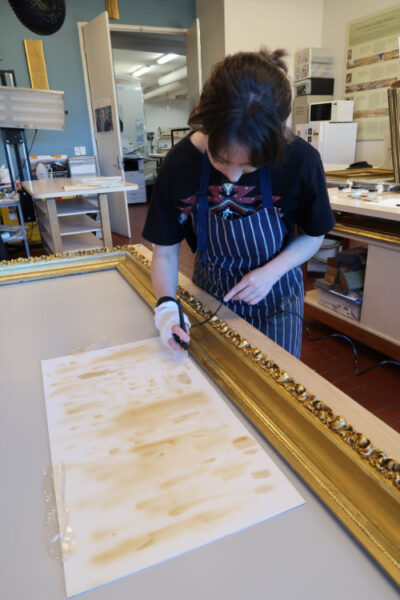
Genevieve carries out localised retouching using an airbrush.
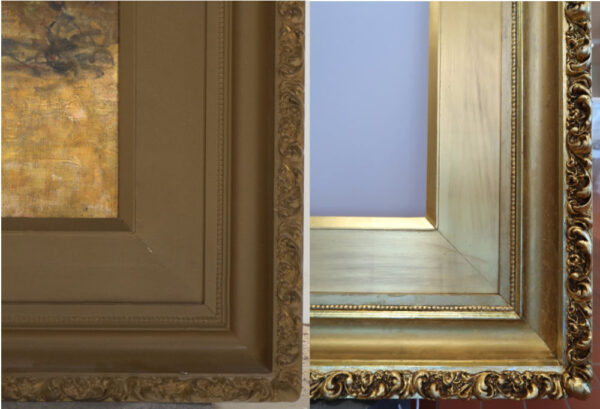
Before and after treatment showcasing the results of removal of overpaint, regilding, glazing and retouching.
Projects and loans
Margaret Sawicki has completed assessments on a significant number of frames for an exciting Old Courts rehang in 2021, which will see many works on display for the first time in a long time. Basia Dabrowa continues to work on loans and is approaching the end of the overpaint removal process for the large Mahony frame.
We have been participating in virtual gallery activities under the AGNSW Together in Art project. Paula Dredge delivers a great discussion on Sidney Nolan’s use of house paint in a short video for the Out of the Box series, which has been well received by colleagues and the public.
Ellie Gifford has completed the archiving documentation of the Sidney Nolan and Lloyd Rees studio materials in the Artists’ Materials Archive and we are very hopeful of having both archives online by the end of the year. Ellie has also been working on preparing paintings for outward loan and treating some new acquisitions as well as helping to prepare some paintings for rehanging in the Australian 20th century collection.
It’s back! Taking advantage of changes in the exhibition schedule, a team led by Sarah Bunn was able to make use of vacant gallery space over the month of July to complete the second phase of processing Chinese Bible by Yang Zhichao. This is a complex work comprising 3000 notebooks. The books were laid out in order, from 1 to 3000, to pencil in accession numbers and finalise the description/condition spreadsheet, before the information is to be migrated onto the collections database as 3000 individual records.
Mim Sterling from the photography department also photographed all 3000 front covers to aid in identification. The team spanned multiple departments, with contributions from: Karolin Wu (Gallery Host), Yin Cao (Curator of Chinese Art), Carolyn Murphy (Head of Conservation), Julia Bavyka and Olga Svyatova (Install), Analiese Treacy and Lois Waters (Paper Conservation), Melanie Barrett and Kerry Head (Objects Conservation), Grace Barrand (Frames Conservator), Ellie Gifford (Paintings Conservation) and Tom Langlands (Reproduction Frame Maker).
The final phase (yes there’s more!) will be creating 3000 barcodes printed on slips of paper inserted inside the front covers, so that updating locations can be done instantly with a scanner; and applying the results of University of Melbourne PhD candidate Cancy Chu’s research to the storage of the plastic-covered notebooks.

Sarah Bunn and Karolin Wu laying out the books for Chinese Bible.
The paper team has also been involved in the preparation of a number of large/complex works on paper, including works by Danie Mellor as part of the 2020 Dobell Australian Drawing Biennial, and Peter Mungkuri’s Punu Ngura (Country with trees) series, for display and photography respectively.
Analiese Treacy, Jonathan Dennis and Lois Waters have been preparing a vast and varied selection of items from the AGNSW Archives for the upcoming Pat Larter exhibition, charting the daring exploits of this Australian feminist artist who was undoubtedly a pioneer in the performing arts for her time. For the upcoming Margel Hinder – Modern in Motion exhibition, Lois has completed stabilisation treatment on a series of Margel Hinder’s sketchbooks, graphite drawings on tracing paper of wire maquettes, and various associated photographic and archival materials.
Analiese has just completed the preparation of works including large-scale photographs by Thomas Demand and Andreas Gursky for outward loan to Auckland Art Gallery Toi o Tāmaki. We are so happy to be able to share these works with our colleagues overseas during this particularly uncertain time.
Jonathan in the mounting department has mounted and framed 14 portrait paintings on paper by Khaled Sabsabi for the exhibition A promise, has prepared 60 works for the Young Archie competition, and has mounted works by Australian artist Peter Drew for the upcoming Archie Plus exhibition running concurrently with the Archibald, Wynne and Sulman art prizes. He continues moonlighting two days per week for time-based art conservation.
Australian Museum
Collection Care and Conservation
Heather Bleechmore, Acting Manager – The Museum has just weeks to go before reopening in October and the Operational Readiness plans have now come online. CC&C staff are working across all galleries to reinstate objects and specimens in showcases and on open display, conduct major cleaning of selected exhibits, and prepare for environmental testing of the new spaces. It will be an intense few weeks during which the new CC&C lab will take shape. Final architectural plans have been approved and builders will be contracted to carry out a refit of the lab, which will improve CC&C’s connection to the AM community, increase flexibility in workspaces and streamline others.
Sheldon Teare and Megan Dean-Jones were interviewed for the Sydney Science Trail for a ‘Careers in Science’ segment. The interview will be part of online content being rolled out as the Science festival shifts to an online format.
Treatment project
In preparation for reopening, the Lord Howe Island Diorama is undergoing a major conservation inspection and treatment. This diorama depicts birds and natural landscapes from Lord Howe Island and is believed to be the oldest diorama in NSW, dating to 1921. Robert Clendon and Megan are spearheading this project, supported by Sheldon, Clare Kim and Rehan Scharenguivel. The Prep department has fitted a huge clean room/tent over the front of the diorama to prevent any cross-contamination of the space. Robert and Megan will meticulously inspect and remove surface dirt from the interior of the diorama, while the rest of the team works on the birds as they are removed temporarily.

Megan and Robert removing birds from diorama.
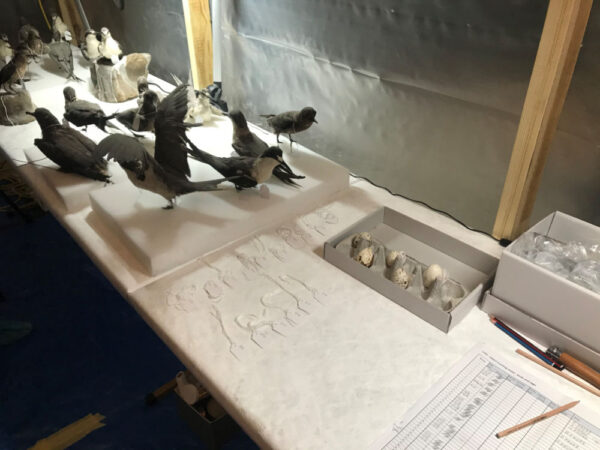
Birds and eggs removed from diorama.
Dry Types project
Irene Finkelde and Melissa Holt have been working in the Mammals and Birds departments to assess and condition report Dry Type specimens. So far in the project they have completed approximately 600 condition reports, with 4,200 documentation photographs captured and linked to the EMu database. Irene and Melissa have been liaising with suppliers to source archival-grade materials and custom-designed boxes to rehouse the specimens later in the project. COVID-19 has slowed the supply of some materials, but the project is progressing at a steady pace.
Research projects
Collection Enhancement project
Clare has been carrying out treatments to damaged entomology specimens from the ‘hospital drawers’. The specimens include Campylomma species (plant bugs), where the full body size of adults is less than 2mm long. Due to their small size, Campylomma specimens are generally pointed (mounted) on acid-free card, and then the card is pinned together with its specimen labels. One of the most common damages found in entomology specimens is broken body parts. They are generally re-mounted on acid-free card for research and taxonomic purposes after thorough condition assessment and documentation. Re-mounting was carried out under a microscope to control the amount of adhesive used and to make sure the adhesive was only placed on less taxonomically important parts of the specimen.
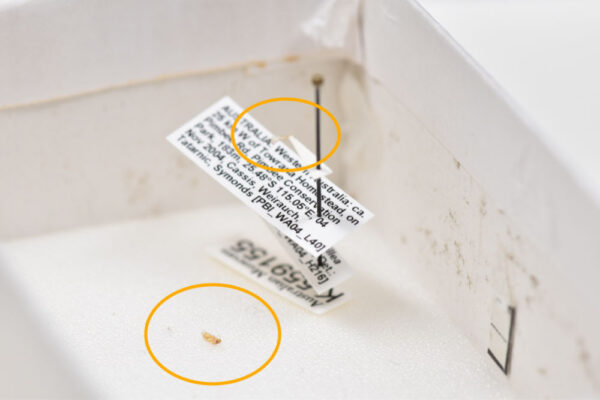
BT image of a Campylomma specimen with broken body parts.
Exhibitions
Megan prepared 27 natural science specimens for a new permanent display in the Museum’s Surviving Australia gallery with a focus on the impacts of climate change on the natural environment. This is the first of several new displays in this gallery with a climate change theme.
Collection care
Rehan has started to develop the IPM program’s reporting system, which is based on blunder-trap catch numbers and feeds into an Excel spreadsheet. Data are then used to auto-generate reports using PowerBi. PowerBi has allowed a simple relational database to be created, which has started to include several preventive conservation indicators to be correlated together and reported on. The system is still being set up, but initial reactions from other Museum departments has been positive. CC&C would greatly appreciate discussing and problem solving collaboratively with other institutions who are investigating similar reporting strategies.
Conference attendance
Staff have attended several online conferences and training courses. Sheldon, Irene, Melissa, Clare and Rehan attended the Annual Society for the Preservation of Natural History Collections conference over Zoom. Irene and Melissa have been viewing the American Institute of Conservation annual meeting presentations, AICCM SC@M webinars and previous Connecting to Collections Care webinars.
Australian National Maritime Museum
Social news
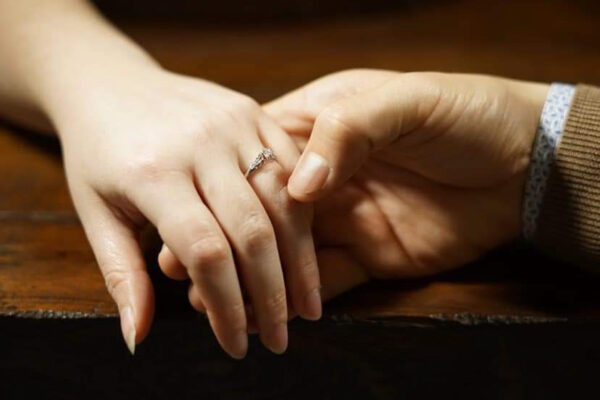
Luci Ronai is engaged! (L Ronai)
Luci Ronai and Ed, her long-time partner, have finally made things official and are now engaged. Congratulations Luci, from everyone here at the museum!
Treatment projects

Agata Rostek-Robak treating the Bradley Log. (L Ronai)
Agata Rostek-Robak has completed her treatment of the log of William Bradley, First Lieutenant of HMS Sirius. The Bradley Log is now on display as part of the museum’s new Under Southern Skies exhibition.
Research projects
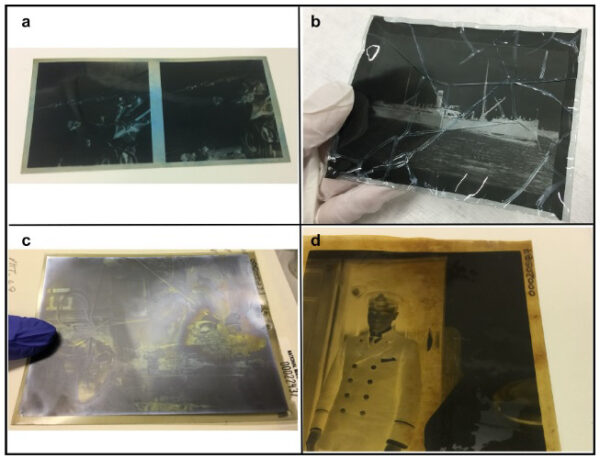
Luci Ronai’s research on the identification of cellulose nitrate and cellulose acetate film stock. (L Ronai)
Luci Ronai with academics from the University of Sydney have had their research on the identification of cellulose nitrate and cellulose acetate film published in the Heritage Science journal.
Exhibitions

Nick Flood working with Rego and Preps to assemble an artwork for the HERE: Kupe to Cook exhibition. (L Ronai)
Nick Flood, Luci and Jeff Fox have installed HERE: Kupe to Cook, a travelling exhibition from Pātaka Art + Museum, New Zealand. There were a number of complicated artworks to install, including a large tapa cloth that was ‘hung’ using magnets

Jeff Fox dusting off Lord Nelson’s epaulettes during the museum shutdown. (L Ronai)
Like many of the country’s museums, ours shut its doors briefly this year. This gave conservation staff a chance to catch up on the maintenance and cleaning of objects on long-term display.
Conference or webinar attendance
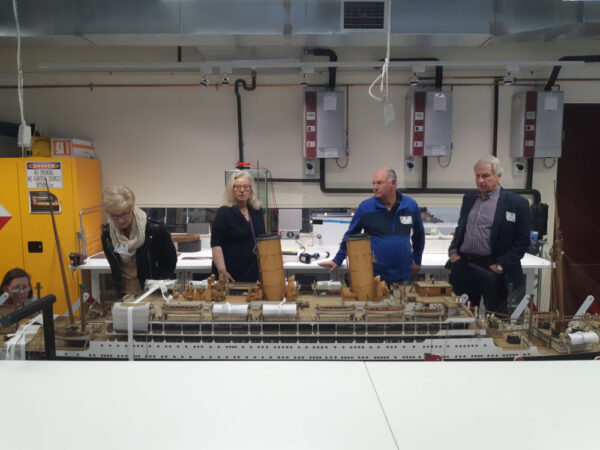
Agata Rostek-Robak leading a tour of the Conservation Lab. (N Flood)
The conservation team has played host to the museum council, donors and staff, guiding them on a tour through our lab.
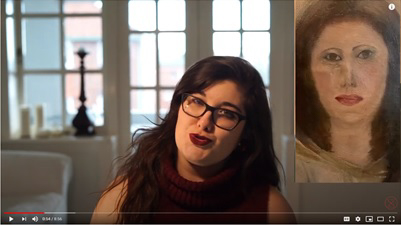
Luci Ronai in her recent Conservation Starter video. (L Ronai)
In her own time, Luci Ronai has continued filming her Conversation Starter series. She now has 16 videos on offer. This one is well worth a watch. Show Luci some love and subscribe to her YouTube channel.
Heights Heritage Conservation
Treatment Projects and Exhibitions
This quarter has certainly been quieter than usual, with just a handful of interesting projects.
In June, Tess Evans completed the cleaning and documentation of a wonderful collection of theatrical costumes that were donated to the Sydney Jewish Museum from the Rosemarie Benjamin Archive – Theatre for Children. The collection consists of 32 individual items of ‘home-made’ costume, many hand-painted, covering a variety of styles and periods. The next stage is to research what the various productions might have been. A nice little project for someone to get their teeth into.
Forty-one hand-carved Ethafoam cap mounts for the Baggy Green collection at the Bradman Museum kept Tess busy too. They are going into a temporary exhibition later in August to commemorate ‘The Don’s’ birthday.
The major challenge this month has been the full restoration of a stunning 1875 framed Fashion Plate complete with silk skirts, underpinnings, lace trims and sequins, hand-sewn through the print to a paper backing. Both the paper and silk were extremely fragile and brittle. Careful unpicking and removal of the textile elements revealed the full colour print underneath and the delicate print on the cream silk fabric. The paper was cleaned and de-acidified and the silk supported with silk crepeline before the whole thing was put back together. A new hand-painted and gilded window mat was created and the original frame was repaired and built out at the back to allow for the depth of the skirts.

Fashion Plate before treatment. (Tess Evans)
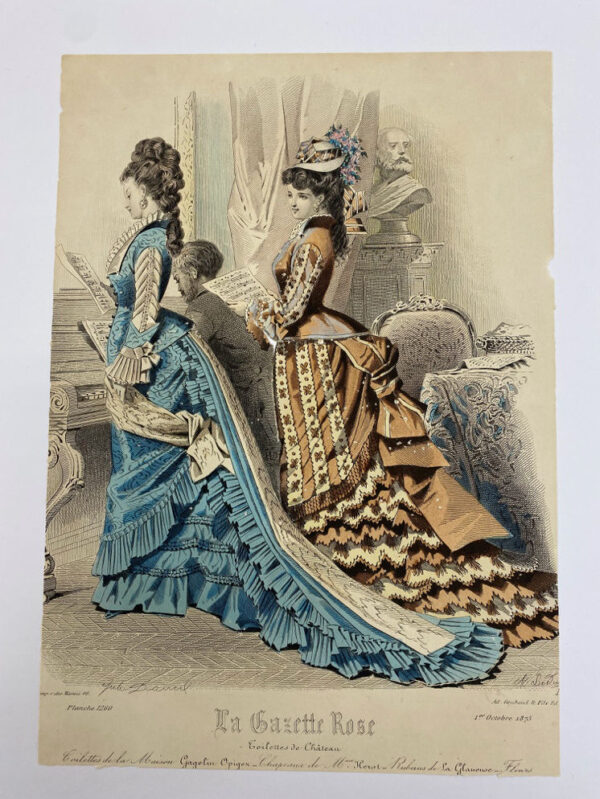
Fashion Plate with textiles removed. (Tess Evans)
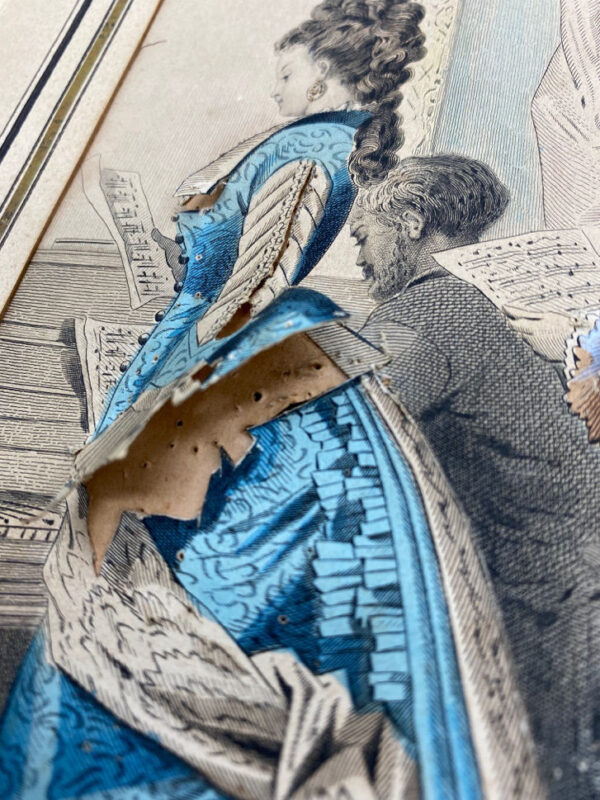
Cut bodice to accommodate skirts showing stitch holes. (Tess Evans)
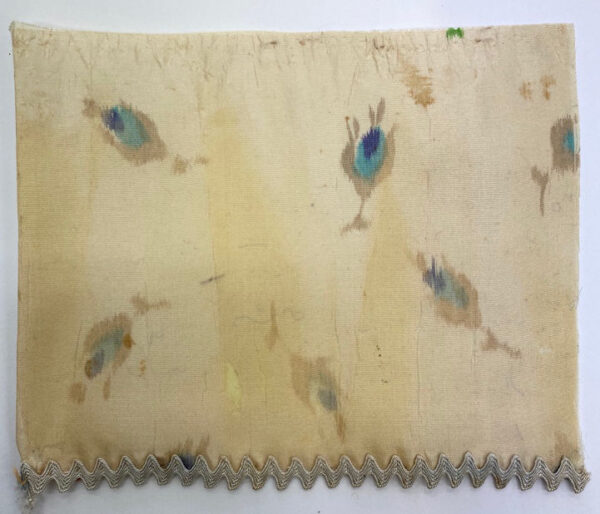
Silk skirt unpicked. (Tess Evans)
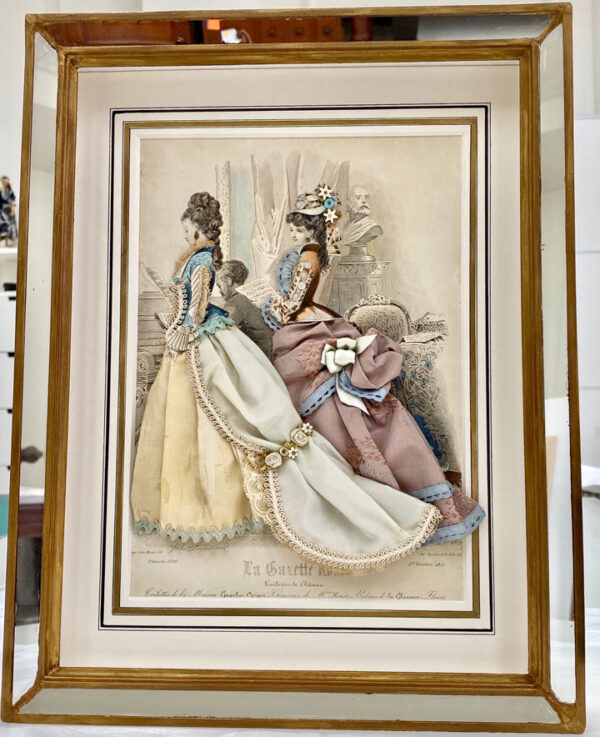
Fashion Plate complete with original mirror-edged frame. (Tess Evans)
International Conservation Services
Textiles
Christina Ritschel has been busy on a range of tapestries and quilts, including removing two large Coburn tapestries from a city foyer requiring not only the standard SWMS but also a comprehensive COVID plan.
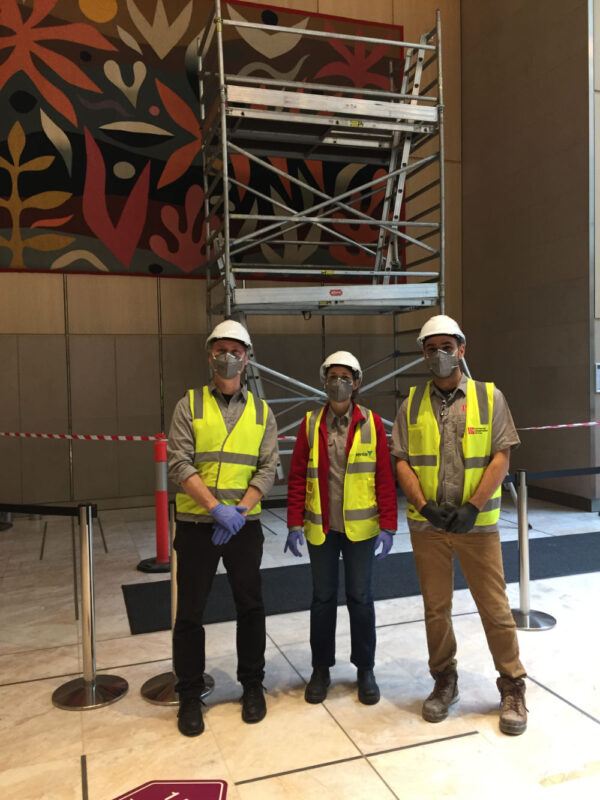
Christina with Sergio Merida and Jochen Letsch, International Conservation Services.
Paintings
A particular focus in the paintings lab has been the treatment of the Pixie O’Harris collection of artworks from Westmead Children’s Hospital. We have filmed various aspects of the treatment and, working with the Westmead curator, a series of videos has been created for the Starlight Foundation For Sick Kids. The half dozen YouTube videos are short and snappy and compare the conservation treatment techniques of paintings to those used by doctors when treating sick kids.
Furniture
Oliver Hull and Shane Wiechnik have completed a large honour board for Neutral Bay Public School, reflecting that interest in maintaining honour boards and war memorials continues beyond the centenary of World War I. At the same time complex treatments of a lacquer screen, a series of brass inlaid tables and some unusual contemporary wooden sculptures ensure the work of a furniture conservator is never boring.
Objects
The treatment of machinery and tools from the Locomotive Workshop at the Australian Technology Park at South Eveleigh continues with increasing pace as the site prepares to welcome its first tenants. Regular challenges include working round the sheer size of the items (some weighing over 30 tonnes) including moving them to access difficult areas.
Meanwhile we are onto the treatment of our second round of artefacts from the Windsor Bridge including the reconstruction of a section of very friable brick drain for exhibition purposes. We are also undertaking a review of the long-term maintenance of the in situ archaeology at Parramatta Justice Precinct, a highly significant site that may well have extant remains of a 1789 (yes!) building.
Outdoor Heritage
A major recent project has been the treatment of the bronze bas reliefs on the Art Gallery of NSW façade. Karina Acton led the ICS team supported by Amy Walsh, Sergio Merida and Wendi Powell to achieve a subtle revelation of the relief and colours of these important artworks. The magnificent Gilbert Bayes horses, known as Offerings of War and Offerings of Peace have also undergone cleaning and wax replenishment.
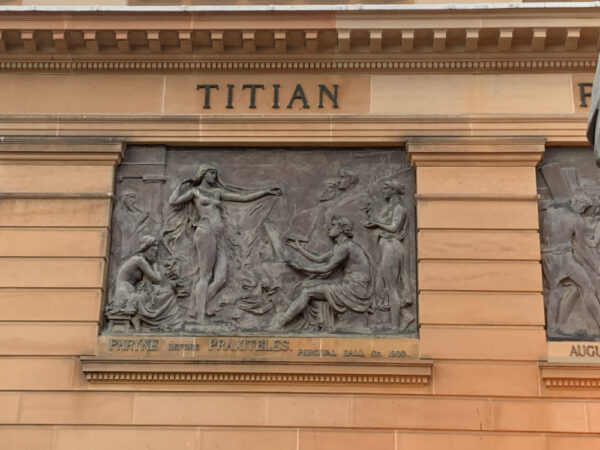
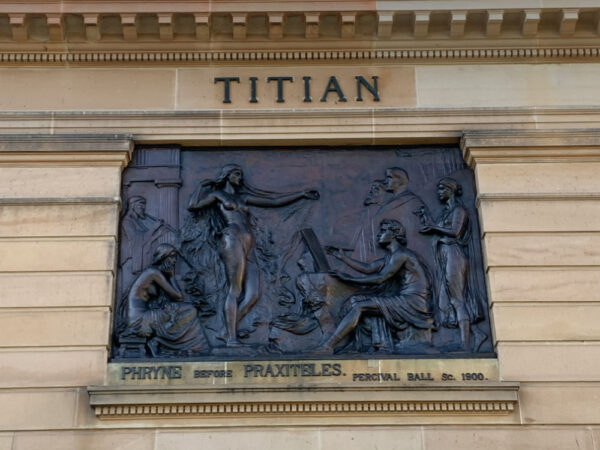
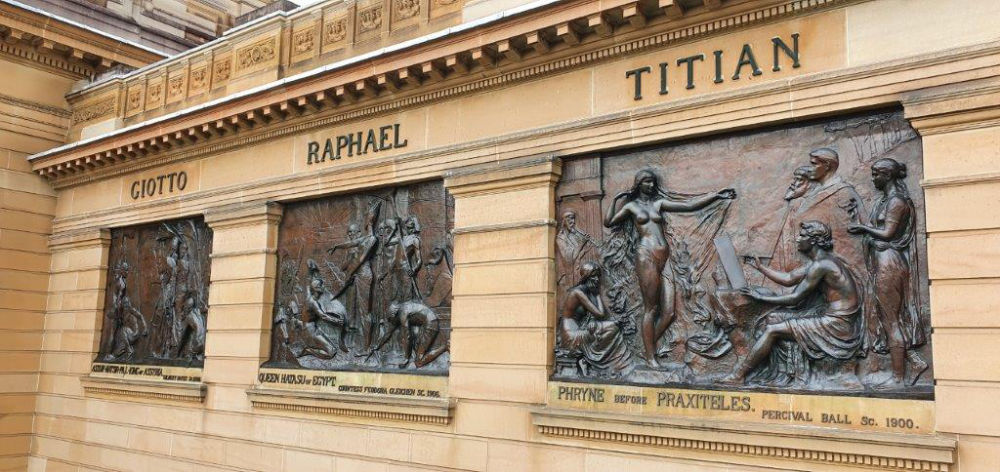
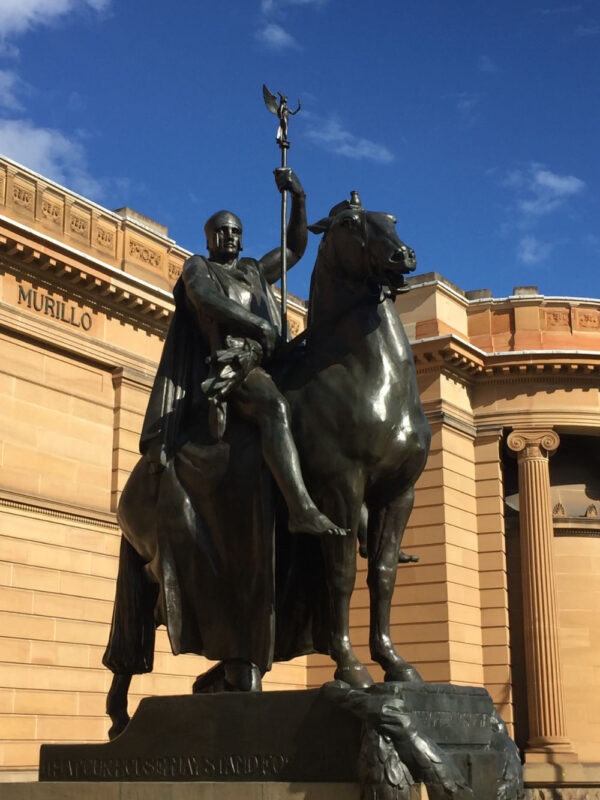
ICS Melbourne
The ICS Melbourne team has adapted to the latest restrictions and continues working on treatments with a range of safety mechanisms in place. Just before the recent lockdown, Frances Paterson and Bruno Bell were able to install a new archaeological display in a city development. All the mounts were made by Bruno, bringing a new skill base to the ICS team. Bruno and Kristine Allinson have also been finalising the Metro Phase One archaeological work.
People
We have farewelled two staff recently. Paintings conservator Julia Vandenberg has sadly returned to her native Netherlands after a couple of years with ICS, during which we have significantly benefitted from her knowledge and expertise.
Senior paper conservator Wendi Powell, after over a decade at ICS, has taken a position with another private facility. Wendi has been a key player in many ICS projects during her time with us and we will miss her greatly. We wish her all the best for her new venture.
Museum of Applied Arts and Sciences
Staff changes
Dave Rockell has been appointed as Senior Conservator, Large Technology Objects, and Ralph Boesel as Conservator, Large Technology Objects. David Livingstone has also joined us as Steam Engine Educator.
Tim Morris has been appointed as Senior Conservator, Castle Hill, and Bronwyn Dunn as Conservator, Castle Hill. Vanessa Pitt has been appointed as Senior Conservator, Exhibitions.
Rebecca Ellis has been appointed as Senior Conservator, Organics, and Skye Mitchell as Senior Conservator, Inorganics. Margot Murray has also joined the conservation team as an Inorganics Conservator.
Rebecca Main has returned after being on leave for six months. She has joined the Collection Relocation and Digitisation (CRD) Project as Lead Paper Conservator.
William Sit has been appointed as CRD Assessment Team Leader and Beate Yule as CRD Assessment Deputy Team Leader. Jessica Walsh has also joined the CRD Assessment Team as an Assistant Conservator.
Monica Podesta has been appointed as CRD Special Collections Team Leader and Karina Lavings as CRD Special Collections Deputy Team Leader. Assistant Conservators Felise Reakes, Emily Vearing, Wajeeda Tabassum and Jessica Gray have transferred from the CRD Assessment Team to the CRD Special Collections Team.
Kris Bullen was briefly appointed as Conservation Laboratory Technician before accepting a permanent position at the Australian Museum. Fiona Hurel has left the Assessment Team to undertake a contract at Artlab Australia, Adelaide.
Project and Treatment update
While the organics team has been focusing on the Museum’s wood and textile collections, the inorganics team has been focusing on the ceramics collections with Margot Murray commencing work on a collection of Cypriot pottery.
Chris Redman has been developing processes and procedures for managing the Museum’s variable media collection. This includes setting up a variable media digitisation studio and producing guidelines for the CRD Assessment Team.
The MAAS collection contains 249 collective archives. The CRD Special Collections Conservation Team is responsible for making recommendations for treatment, handling, packing and storage. The team has completed assessment of the Hargrave, Robert Rosen ‘Two Gun’ and Snowy Hydro Electric Scheme Archives. The team has also assessed part of the Museum’s variable media collection and is working in collaboration with the digitisation studio to test equipment and processes.
Bronwyn Dunn is currently chair of the AICCM Education and Training Committee. The ETC Wiki will be available in the next few weeks and welcomes content from AICCM members who know of any helpful education and/or training opportunities.
Exhibitions
Although the Powerhouse Museum has re-opened, the Sydney Observatory and Museums Discovery Centre remain temporarily closed to the public.
Teresa Werstak de-installed Apollo 11. Gosia Dudek de-installed Icons. Teresa and Gosia were also involved in the installation of Maton: Australia’s Guitar. The exhibition is the largest retrospective of Australia’s leading guitar manufacturer and features over 130 guitars.
Loans
Collection items on loan to the National Art School as part of the Biennale of Sydney will now be on display at Carriageworks.
Several collection items from the Decorative Arts collection will be travelling to Brisbane as part of the Bauhaus Now exhibition at the Museum of Brisbane. A collection of audio-visual material will also be travelling to Melbourne in support of the Australian Centre for the Moving Image renewal project.
Preparations continues for a large loan of objects for the China: Auspicious Creatures exhibition at the Chau Chak Wing Museum at Sydney University.
O’Sullivan Conservation
Professional news
O’Sullivan Conservation is proud to be a COVID-safe business, with a COVID-19 Safety Plan in place and all staff trained for a COVID-safe workplace.
With the COVID-19 pandemic showing no signs of easing globally, and with lockdowns and social distancing measures in place, Hannah has taken advantage of being office-bound and completed the website update that commenced in August 2019. This has resulted in a complete overhaul of the website, including the introduction of a health and safety page, an update of our services offered, and a refresh of our projects page.
In January, O’Sullivan Conservation welcomed a new full-time Assistant Objects Conservator, Kaleigh Kenney, and she has continued to work well within the team during challenging times.
Treatment projects
At the end of June, Eoin and the team completed an extensive conservation treatment of the Governor Phillip Fountain in the Royal Botanic Garden, Sydney. This project included conservation of the bronze works, replacement of failing pointing, trial poulticing to remove copper staining from the marble and hand-cleaning of the marble, as well as overseeing the waterproofing of the four water basins.

Governor Phillip Fountain – before treatment.

Governor Phillip Fountain – after treatment.
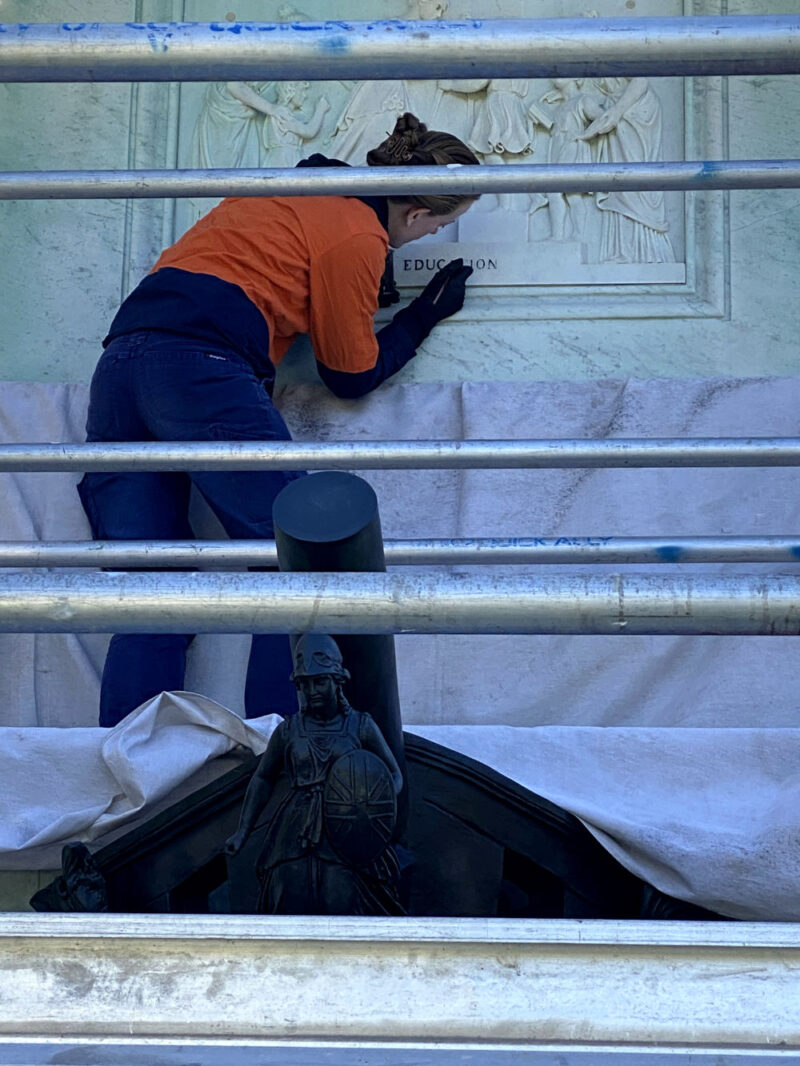
Governor Phillip Fountain – Kaleigh inpainting incised lettering.
The focus then shifted to other projects in the workshop, including a conservation treatment of two WW1 machine guns and several ceramic repairs.
Eoin and Kaleigh have just commenced a conservation treatment on a bronze sculpture of Sir John Robertson, which has an active beehive inside, complete with honey and bees. The bees are keeping them on their toes and are an interesting safety challenge each day on-site.
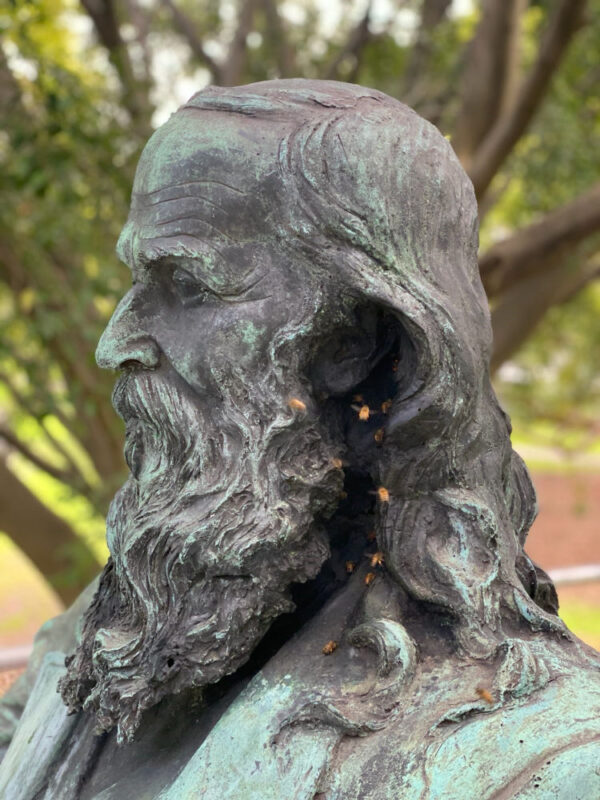
Sir John Robertson – before treatment bee activity.
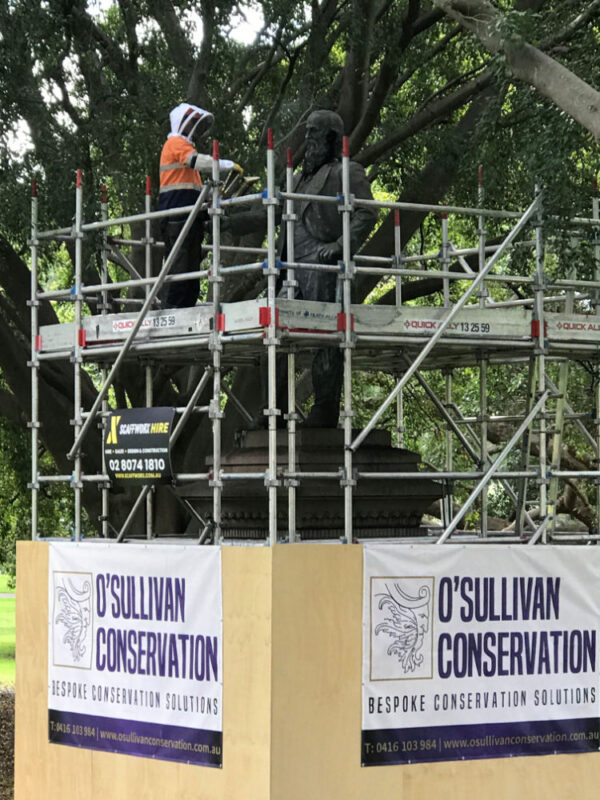
Sir John Robertson – Eoin undertaking smoking the bees prior to commencing treatment.
Conference attendance
Like many others in the conservation community, Eoin and Hannah had planned on attending the IIC built heritage conference in Edinburgh, Scotland, in November. While no longer able to attend in person due to COVID-19, they are looking forward to virtual attendance.
As a positive, COVID-19 has presented additional opportunities to attend international conservation conferences through 2020 that are now being offered virtually, such as the Art/Switch 2020 conference on sustainability in the arts.
State Library of NSW
Staff changes
The Collection Care Digital Excellence team (DEP) welcomed assistant conservator Paula Thorby in July. Paula has moved across from the Preservation team and slotted straight into DEP. Welcome, Paula, to the team!
Book Conservator Nicole Ellis, of the Books, Objects and Paintings team, joined the Preservation team in July for an initial six months. While she will be greatly missed by the BOP team, this move will allow her to contribute to preventive conservation projects, procedures and policy development.
Meg Driver, Registrar, has been with Collection Care for the past year and finished her contract on 17 July as Lauren Dalla returned from parental leave at the end of July. Meg’s support for exhibitions and loans, and her contribution to the Branch, have been greatly appreciated.
Felicity Corkill returned to the Library on 6 July after parental leave, and Kate Hughes, who has been acting in the role of Senior Conservator, Books, Objects and Paintings team, for the past year, returned to the Paper and Photographic team on 29 June.
Ruth Drayson finished her contract at the end of June as a conservator in the Paper and Photographic team.
The branch welcomes the return of Bronwen Glover to the Library. Bronwen completed a year-long fellowship at CCI in book conservation, where she worked on book and paper conservation treatments and practised new and interesting bookbinding techniques. Bronwen has been working remotely with the Preservation team from Ontario, Canada, since June.
Professional news
While the Library has been open to the public since June, Collection Care staff continue to balance working on-site with working from home. For the Paper and Photographic team, this has made it difficult to put in deadline-driven achievements, as deadlines have stretched well into the future both for in-house exhibitions and our external loans program.
The Library is currently developing a Map Room, to showcase the Library’s extensive map collection. Conservation treatment and mounting of items from the 17th to 20th century relating to exploration of the Pacific are underway.
Kate Hughes has been working with Anne Cummins on the conservation and cleaning of the Banks Endeavour silver globe punch bowl, a new acquisition, which will also grace the map room when it opens—hopefully—in November.
Wendy Richards has been conserving items from a new acquisition of a recently acquired archive of Pamela Allen material, which will be on display from the end of August. These are Allen’s working drawings and mock-up trials for her children’s books and are filled with Magic Tape so finding the delicate balance between treatment, artist’s technique and method in treating the material is complex.
Despite the limitations of lockdown, the Library has continued to acquire material and Trish Leen has been working through newly catalogued collections and individual items that require conservation treatment and rehousing prior to digitisation. These include plans, drawings and lists of plantings of gardens by Jocelyn Brown who designed private gardens in the Northern and Eastern suburbs of Sydney during the 1940s and 50s.
Dana Kahabka is continuing work on reducing the varnish on the Tasman map and Cecilia Harvey has been assisting the Storage team at the off-site store at Moorebank, preparing for collection moves.
Similarly, the DEP team has been working both on-site and at home. Kiki Lawler-Dormer and Hoa Huynh have been working with Annie Breslin, our moving image specialist, in preparing significant and at risk sprocketed 16mm film for digitisation as part of the Moving Image Project. The team performed transit winding for 34 film reels over three days and carefully packed items in archival film cans to ensure safe handling and minimal movement during shipment. The team also completed treatment of Edmund Blacket’s architectural plans. This has been a significant achievement for the team as the Blacket plans have been a large project in the digitisation program for the past three years.
The DEP team has also recently completed rehousing all 47 of the Library’s Miles Franklin pocket notebooks. Franklin was known as a diarist and kept an annual diary from 1909 until the end of her life. The DEP team rehoused each pocketbook in individual four-flap folders and then in one clamshell box. It took some lateral Tetris-like thinking to work out how to fit all 47 books into the one box!
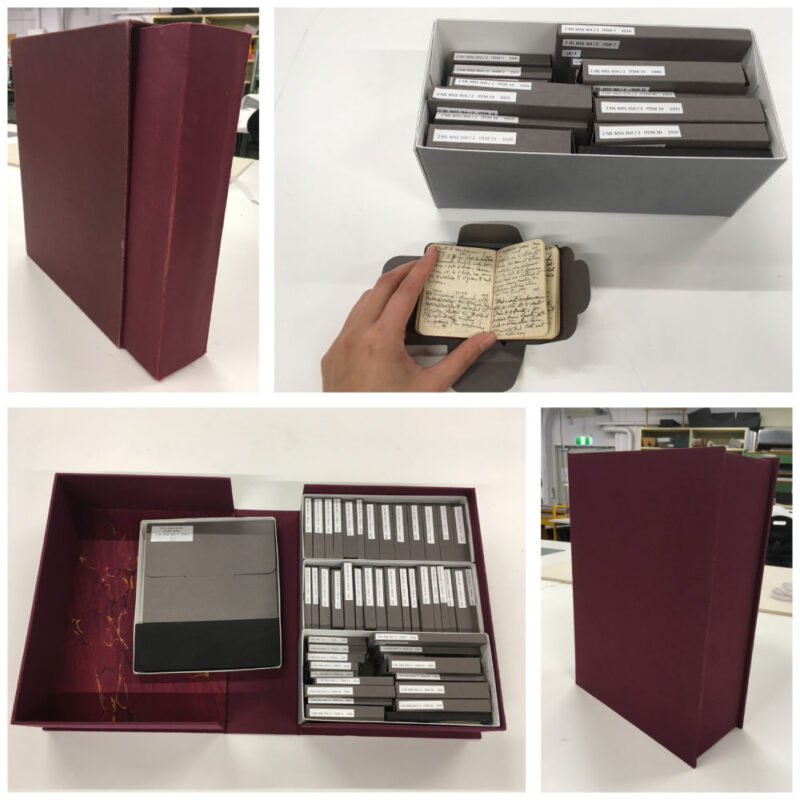
Top left: Miles Franklin’s pocket notebooks were previously housed in a slip case. Top right: the smallest pocket notebook in a new four-flap folder. Bottom left: the pocket notebooks housed in trays within a clamshell box. Bottom right: Miles Franklin’s pocket notebooks in a new clamshell box.
Exhibitions
Helen Casey and Cath Bartley installed the new Eight Days in Kamay exhibition, which opened on 13 July – an Indigenous response to Cook’s 250th anniversary. The exhibition was delayed due to the pandemic, but the Library had launched an innovative online exhibition, which now is a wonderful complement to the physical exhibition. This is something we are looking at continuing, going forward. The team is now working on an exhibition called Pandemic based on historic collection items relating to the 1918 Spanish flu and recent acquisitions related to the current COVID-19 pandemic.
Conference attendance
The Collection Care staff have been virtually attending the AIC 2020 Virtual Meeting (48th Annual Meeting). To adapt to an online delivery platform, the conference program consists of 50–75 hours of programming spread across three months. With no sessions running concurrently and presentations recorded, staff have been able to attend more sessions than would otherwise have been possible during in-person meeting. This has been an excellent opportunity for staff to attend an international conference within the comfort of their homes!
Collection Care labs update
The development of the new Collection Care conservation labs is well underway. The contract was awarded in May and at the time of writing the demolition work is complete and partition walls are under construction. The conversion of two former library book stacks and a plant room in the oldest heritage-protected part of the building has posed some challenges. The fixtures, furniture and equipment for the new spaces are in the process of being finalised by the Lab User Group (representatives of the teams in Collection Care), with the project due for completion in late November.
Collection storage
The Collection Storage Coordinator has been busy planning the relocation to the State Library site, approx. 9000 linear metres of manuscripts, which have been stored off-site since 2016. New mobile shelving will soon be installed in a refurbished library stack, with new a/c and sprinkler layout.
In addition, 140 map/plan cabinets will soon be arriving in stages for re-housing maps and plans, with the aim of improving WHS during retrieval and increasing storage capacity (in the same footprint as the present cabinets).
Queensland
Queensland Art Gallery / Gallery of Modern Art (QAGOMA)
The dual-site nature of QAGOMA has meant conservators across both buildings have been able to continue working safely while maintaining social distancing. Flexible working arrangements remain where conservators within the same department can work remotely where necessary, or choose to work on site on alternate days. Following the easing of COVID-19 restrictions, the public has been welcomed back to both galleries with strict measures in place to ensure the health and wellbeing of visitors, staff, volunteers and the wider gallery community.
Paper Conservation
With the recent reopening of QAG and GOMA, the Paper Conservation team has been kept very busy condition assessing, treating, mounting and framing many artworks for a jam-packed exhibition program.
Graduate Paper Conservation Intern Laura Daenke and Mount Cutting Technician David Rousell have also recently completed the conservation treatment and rehousing of a series of 80 framed chromogenic photographic prints by Gavin Hipkins. This project was worked on two days a week over an eight-week period. The series proved challenging and time consuming to work on as the prints were mounted directly onto a backing board of either pasteboard or foam-core board. The securing staples had been driven directly into the boards, causing damage and tension in the artworks. Each artwork was carefully unframed, condition assessed, consolidated and appropriately reframed.
Laura has also been undertaking the treatment of numerous 16th-century historic engravings, many of which have been trimmed in the past, in preparation for an upcoming International Gallery hang. Once conservation treatment has been completed, the prints will be inlaid into an appropriate Japanese tissue for handling and mounting.
Kim Barrett has been preparing a number of 19th-century photographic prints for another International Gallery hang and exploring options for reducing foxing in-situ on album pages – stay tuned for progress, or please share if you have any helpful tips or success stories.
Sam Shellard and Laura have prepared 200 drawings by Robert MacPherson in preparation for an ongoing program of touring exhibitions to Queensland’s network of regional galleries. The drawings were mounted within 20 large frames (10 in each frame). The careful attachment of 800 individual Japanese tissue hinges was required for this project!
We have also been looking at gallery lighting and Kim has been working with facilities staff on LED lighting upgrades and navigating best practice for LED gallery lighting.
Collections online project
Rhiannon Walker has moved across from IPM and Exhibitions to work on the Collection Online Project. She’ll be working closely with the Imaging and Registration teams to see 7500 collection works photographed for an online presence. Many have never been displayed before, so this is a great opportunity to condition check and capture installation requirements for a huge part of the collection.
Sculpture Conservation
Over the last six strange months, the Sculpture team has remained working on-site part time on new acquisitions, ongoing IPM and prepping work for upcoming exhibitions, as well as working from home. The team has caught up on the never-ending filing but has also been working on several diverse and complex installation manuals for: Untitled (giran) by Jonathon Jones – consisting of 1742 feathered sculptures exhibited on a curved wall surrounded by sound; Snowman by Fischli and Weiss – an actual snowman in his own vitrine, smiling out at the public; House – Spirit by Lyno Vuth – a monumental tower of 110 shrines; Field guard (from The Power Tool series) by Dennis Oppenheim – electrically powered drills twirling black-suited figures on an anodised platform; and The Couple by Patricia Piccinini – a pair of hyperreal part-human and part-bear creatures reclining inside a furnished tent.
The team has also been preparing for the influx of 100 motorbikes from all around the world for QAGOMA’s upcoming exhibition The Motorcycle: Design, Art, Desire, due to open at the end of November.
Paintings Conservation
Anne Carter and Gillian Osmond have been working on their collaborative research projects for publication as well as preparing a number of large-scale works for installation at the recently reopened GOMA. This included a multi-panelled Brett Whiteley, complete with a mummified cat’s head. Anne has been updating the QAGOMA Conservation blog with exciting new content. Check out her recent post about technical analysis of The Master of Frankfurt’s Virgin and Child with Saint James the Pilgrim, Saint Catherine and the Donor with Saint Peter c.1496. X-radiography helped reveal hidden secrets about an elusive half-man half-woman figure in the oldest European painting in the collection.
The Paintings team has also been busy preparing for Unfinished Business: The Art of Gordon Bennett, a retrospective exhibition due to open in November. Graduate Painting Conservation Intern Madeleine Ewing has been working on major and minor treatments in preparation for the show. She has been experimenting with innovative fill techniques for a painting with unique damage that requires major structural treatment. Madeleine joined the team in January and has also been assisting Gillian with the preparation of several Arthur Streeton paintings for loan to the AGNSW for their upcoming exhibition.
Emily Kelleher also joined the Paintings team earlier this year, backfilling for Conservation Technician Mandy Smith, who is currently on long service leave. Emily has been supporting the preventive conservation program and finds herself busy collaborating with workshop and Conservation Framing to devise hanging systems and fit paintings into handling frames for safe travel and storage.
Frames Conservation
Over the past few months, the Conservation Frames and Furniture Studio has been working on-site with only a brief period working from home. Damian Buckley is continuing the major restoration treatment of the frame on Henry Short’s Fruit and flowers, 1859. Emily is assisting Damian with this project and is also undertaking a comprehensive assessment of the picture frames in the QAGOMA collection.
Alex Forrest has begun construction of a new stretcher for Sally Gabori’s Makarrki. Measuring 1978mm x 4538mm, this is one of the largest stretchers made in-house. Alex is also continuing work on the newly designed works-on-paper frames. After extensive research and consultation, Robert Zilli has commenced the manufacture of a suite of 11 replica 16th-century German frames for Albrecht Durer works on paper.
Collection environment
Amanda Pagliarino has continued her work on the Gallery’s collection and display environments, recently reaching a milestone in a collaborative project with Honeywell to increase HVAC functional settings at GOMA. With this work, functional settings for individual air-handling units in exhibition spaces can now be set at any of six pre-calibrated temperature and RH ranges, giving the Gallery significant control over gallery climate and energy usage. Also, over the past year, Amanda and Ainslee Meredith have been working on a research paper mapping climate change predictions with national, state and regional cultural heritage collections. This paper will be published in the forthcoming edition of the AICCM Bulletin.
South Australia
Artlab Australia
Textiles Lab
In the Textiles Lab, Kristin Phillips and Mary-Anne Gooden have been preparing works for the Art Gallery of South Australia’s Samurai exhibition. We are very thankful for the assistance of Vanessa Liew, an intern from the Heritage Conservation Centre in Singapore, earlier this year before she returned home ahead of schedule due to COVID-19 restrictions.
The treatment of a kesa (priest’s robe) necessitated the patience of both Vanessa and Kristin (and a substantial quantity of dyed nylon net!). Kesa robes have a very basic rectangular form with no sleeves or collar. They are constructed from a patchwork of fabric squares and rectangles according to a formalised structure with associated symbolic meaning. This particular kesa was made from patches of silk brocade fabric of which many of the silk float threads have split. Nylon netting was stitched to the front face of the kesa to encapsulate these fragile areas of damage and cut back to reveal undamaged sections.
This exhibition also provided the opportunity to revisit our design of armature used to display large robes. Made from strips of aluminium bar that are bent and riveted together, the armatures now incorporate magnets, enabling an easier and more flexible mounting process. See Artlab website for time lapse www.artlabaustralia.com.au .
Senior Objects Conservator Justin Gare and Mary-Anne worked to design and construct a suitable armature and mounting system to display late 17th-century Samurai armour. The challenge was to create the impression of an absent body whilst ensuring the garment is fully supported. Many adjustments were needed to attain the appropriate proportions and posture, balancing the physical conservation needs with curatorial aesthetics and visitor expectations. See Artlab website for time lapse www.artlabaustralia.com.au .
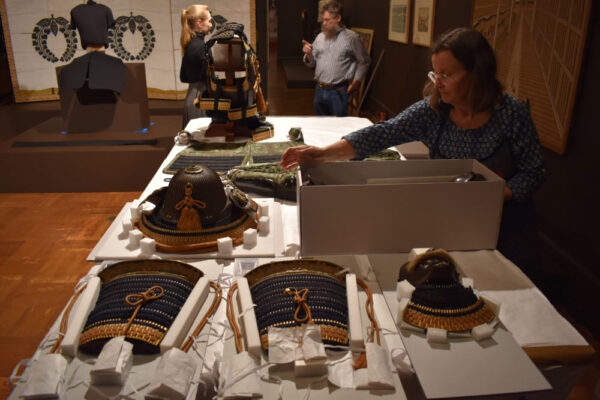
Image 1: Preparing to assemble the components of Samurai armour, with breastplate depicting Fudō-myōō and inscribed ‘A Fortuitous Day, the 8th month of the 12th year of Genroku (1699), Myochin Munesuke’, Art Gallery of South Australia, Adelaide. Storage beautifully prepared by Objects Conservators Filipa Quintela and Megan Sypek. Photo: Artlab Australia.
Justin constructed the torso from timber with slots to accommodate the insertion of arms (of aluminium bars covered with foam pool noodles) as well as the neck/head support (of timber and aluminium bars).
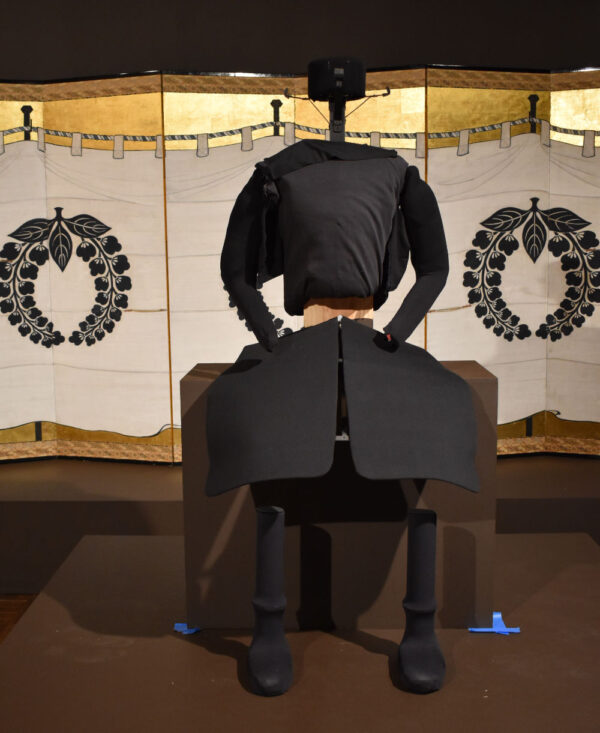
Image 2: Armature constructed from fabric-covered timber, aluminium bars, Corflute and pool noodles. For display of Samurai armour at the Art Gallery of South Australia. Photo: Artlab Australia.
The impression of legs was provided by mounting the thigh guards (using magnets) onto a floating curved ‘lap’-shaped form. This form was achieved by riveting thin Corflute onto a curved aluminium armature.

Image 3: Using fabric-covered magnets to position thigh guards of Samurai armour onto ‘lap’-shaped mount. Photo: Artlab Australia.
Justin incorporated a hook onto the timber torso enabling the ‘lap’ to be easily secured into position. Fabric-covered pool noodles proved to be the perfect solution for supporting the lower legs and feet.
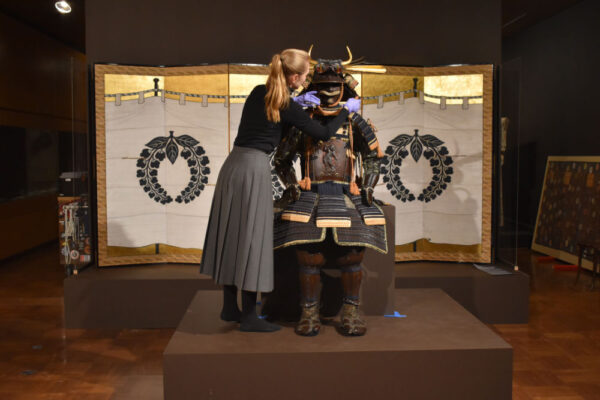
Image 4: Samurai armour, with breastplate depicting Fudō-myōō and inscribed ‘A Fortuitous Day, the 8th month of the 12th year of Genroku (1699), Myochin Munesuke’, Art Gallery of South Australia, Adelaide. Photo: Artlab Australia.
Tasmania
Libraries Tasmania and the Tasmanian Archives
Conservation, Government Archives and Preservation
Current projects
Work in the conservation lab has returned to normal now that the Library and Archives are open again to the public. We continue to provide advice and assistance with collection materials to staff and members of the public.
Gaynor Tollard (Conservation Officer) has been continuing her production of custom storage boxes for a wide range of fragile and unique archive volumes. One recent job was for the Lake Pedder Restoration Committee records, which were deposited with us recently.
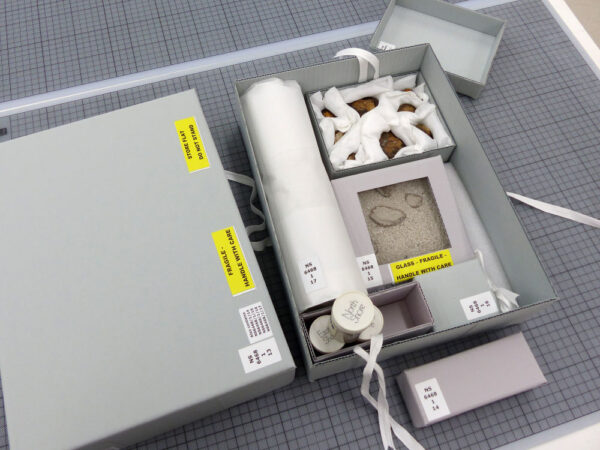
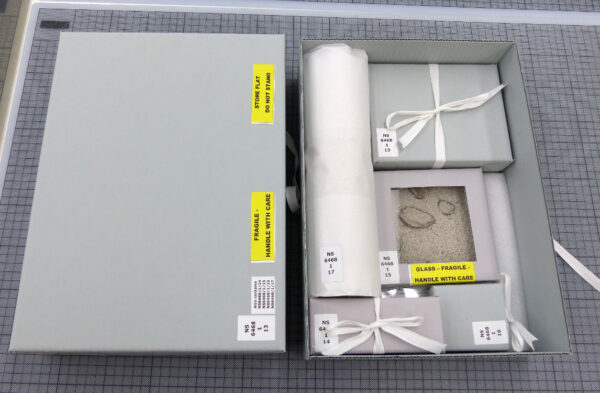
Custom-made boxes for Lake Pedder geological specimens, Pedder sand, ink stamp and time capsule.
Stephanie McDonald has been planning the work and projects for the next financial year and working on several items including a number of photographs needing repair. She has also treated a very fragile architectural blueprint plan of Penghana, the Mount Lyell Mine manager’s house in Queenstown, Tas. It involved the removal of pressure-sensitive tape, followed by repair and lining.
Tasmanian Museum and Art Gallery
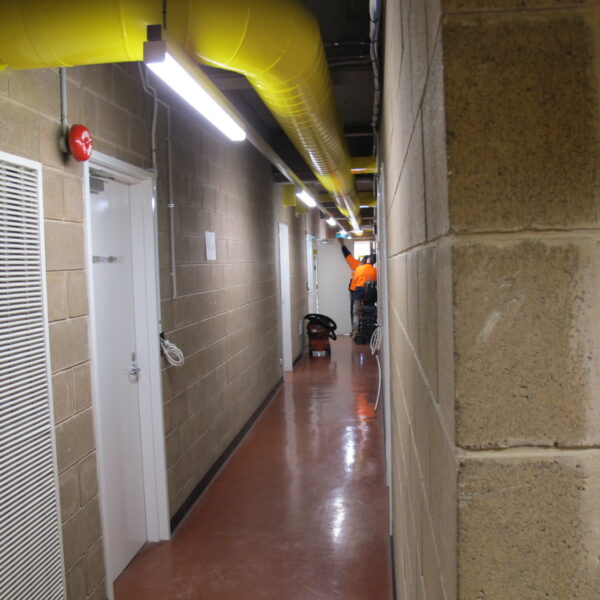
The COVID-19 situation has led to an opportunity at the TMAG to replace infrastructure – so, new carpets in public areas, painting, new lighting and security system upgrades at all of our sites. We have met a lot of friendly contractors and life is starting to return to a routine (of sorts).
In the Paper Lab, Cobus van Breda has been working on the nine portraits in the collection by Thomas Griffiths Wainewright. Most have undergone undocumented treatments in the past (probably over 30 years ago), often involving Masonite, which is proving interesting …
The closing of the gallery for a short period allowed painting conservator Jenny O’Connell time to unframe and condition check some of the iconic paintings that are rarely removed from display, while also allowing time for them to be rephotographed by the reproduction department. As the exhibitions schedule has been delayed, conservators have worked on other major projects such as policy review and object changeovers in the permanent displays. One policy achievement has been the adoption of the Bizot guidelines in TMAG loan agreements, which is a direct outcome of the Environmental Guidelines Roundtable at the NGV in 2019.
Unanticipated space in the exhibitions and loans schedule due to COVID-19 shutdown equals silver linings! Conservation technician Lisa Charleston has had the opportunity to shine a task light into some pretty dark and dusty corners. This has included locating, documenting and reorganising some hundreds of empty or unregistered frames over three sites, systematic maintenance and cleaning of permanent displays with Exhibitions staff, and catching up with a backlog of Art collection items requiring refitting.
Objects conservator Nikki King Smith is surging ahead with long-term storage developments for the shell necklaces and tapa collections, as well as the reorganising of the larger object collection store in Moonah. Work that can be painfully long term in normal circumstances, is now able to be quickly developed and instigated (money dependent, but we won’t talk about that).
Victoria
Arts Centre Melbourne
The last few months have been an interesting exercise in resilience, patience and responsiveness. The COVID-19 pandemic has meant that Arts Centre Melbourne and the Australian Music Vault have been closed to staff and the public since 16 March 2020.
State Theatre fly system upgrade
One project that has been able to continue is the upgrade of the State Theatre fly system. The fly system is the grid and mechanical system that raises and lowers the huge sets and backdrops for all performances in the theatre. Located at the front of the grid is the heritage-listed State Theatre curtain. In anticipation of the works currently underway, the curtain was moved by a large team of stage, production and collections personnel. Previous condition reporting and risk assessment informed the de-installation process for this large painted textile, each side of which measures approximately 11 metres. The main challenge with moving this large textile was keeping the painted design as planar as possible to avoid further cracking. The method of lowering the head baton to the stage floor whilst paying out the curtain and then transferring it to another truss was a slow and delicate process. The key was careful handling by many individuals to ensure even tensioning across the textile and the use of a flexible support to facilitate handling. The curtain has now been stored safely in its vertical hanging position in the auditorium, away from the construction occurring on-stage behind the fire screen.
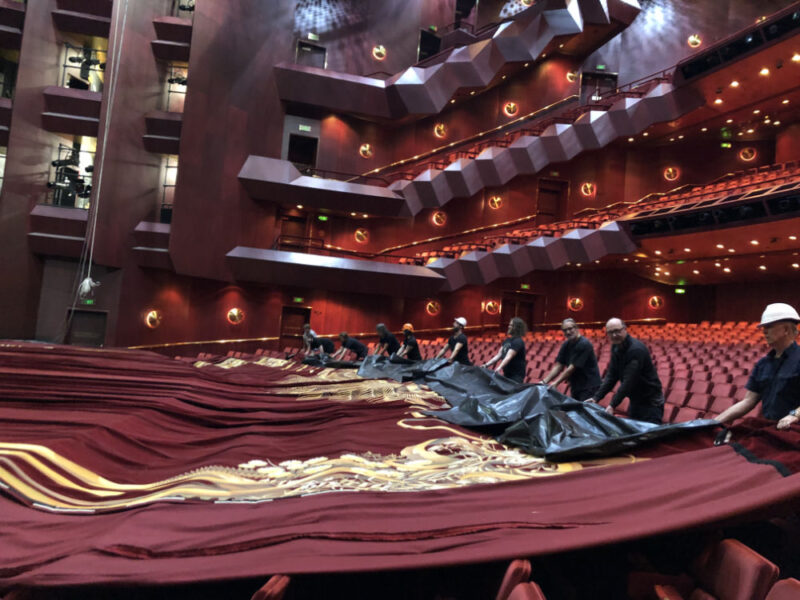
State Theatre curtain deinstallation
Monitoring collections
Unlike many of the other cultural institutions across Melbourne, collections staff and conservator Carmela Lonetti have been required to work exclusively from home. There has been virtually no access to the buildings or the Australian Performing Arts Collection (APAC) since closure. Operating primarily as a performing arts venue rather than museum or gallery, the approach by the executive has been quite different. The Security and Facilities management team has been tasked with monitoring and maintaining the integrity of the buildings, including the collection store and display areas. This situation has given rise to the opportunity of further strengthening collaborations with these colleagues during closure. With conservation direction, the Security team undertakes regular walk-throughs of the store and display areas, monitoring security and building integrity (leaks). The Facilities team has been providing environmental data accessed remotely from the Building Management System and IPM reporting for conservation oversight. The other risk factor that has been identified during this period is the potential vibration to the theatre’s building as a consequence of construction works. Due to the fragility of some of the objects on display, a vibration-monitoring data logger has been deployed in the permanent Australian Music Vault exhibition space as a precautionary measure.
Grand online exhibition
COVID-19 has provided the APAC with an opportunity to increase access to its collections in the digital space. An amazing achievement has been the launch of the Grand online exhibition on 5 August 2020. In 2019, the APAC welcomed a donation from Opera Australia of 30 complete costumes worn by Dame Joan Sutherland in significant performances throughout her career. The culmination of a massive documentation and re-housing project was the impetus behind this online exhibition that reveals some of Dame Sutherland’s historic performances but also explores alternative methods of capturing the collection through 3D scanning and photogrammetry. We acknowledge the contribution of Karen Fisher who worked on the project whilst on secondment from Museum Victoria, and Erina McCann who helped to re-house the collection. We invite everyone to access the online exhibition on the Arts Centre Melbourne website
Grimwade Centre for Cultural Materials Conservation, The University of Melbourne
Grimwade Conservation Services
As we head into the second half of 2020 the team at Grimwade Conservation Services, like many of our colleagues around the world, continues to face significant disruption to business as usual activity in the labs. The volume of work has not diminished but our operations have required significant adaptation to meet the new challenge of operating effectively in an ever-changing COVID-19 environment. Face-to-face consultations are replaced with online Zoom sessions, research work is done from the home office, and lab treatments are carefully rostered to ensure maximum use of lab time whilst maintaining social distancing and workplace capacity protocols. And as Melbourne progresses into Stage 4 lockdown we are continuing to operate with a limited number of Working Permits issued to staff for emergency works and regular lab monitoring, and a range of home-based conservation activities which have been approved to proceed following intensive OH&S and risk assessment reviews.
Two of our conservators have written about the creative adaptation of conservation and the challenges of working from home for online creative industries journal Gabberish. Paper Conservator Peter Mitchelson has been making book supports, while Textiles Conservator Victoria Thomas has been creating a dye reference library. In this issue of AICCM E-News, objects conservator Holly Jones-Amin also discusses how archaeological first aid has been possible through work-from-home.
Grimwade Centre Academic Programs
While the academic program at the Grimwade Centre for Cultural Materials Conservation has been exploring notions of ‘limitability’ even more and at each turn, re-versioning its ‘Roadmap’ and OHS guidelines, our online communication platform, Conservation Student Resources, has been getting a real workout as we modify protocols to keep everyone safe and limit community transmissions. As you know, some of our subjects in the first part of the year shifted to online learning for the theoretical content with Catch-up Practical Bootcamps if needed. Lecturer Robert Lazarus for ‘Digital Protocols’ was fortunate to involve the Tate’s Patricia Falcao from London and Mick Newnham from Canberra. So remote learning also offers advantages in engaging experts from far away.
Robyn Sloggett with Hannah Stewart and Marcelle Scott did the same for ‘Ngarrangarni: Gija Art and Country’ where senior Indigenous knowledge holders from the Warmun Community in Western Australia engaged with our Master’s students remotely. A great deal of effort was put into migrating video material, and our long-term relationship with the community ensured its success. Six months ago, this would not have seemed possible. For those who would like to know more, go to ‘Made Possible by Melbourne’ . We thank our Friends of Warmun, who have provided support.
Petronella Nel is currently teaching the materials science based subjects and working out clever ways to interact and to keep everyone safe with social distancing in the laboratory (Image 1). This is with the help of our PhD students and Diana Tay (Image 2).
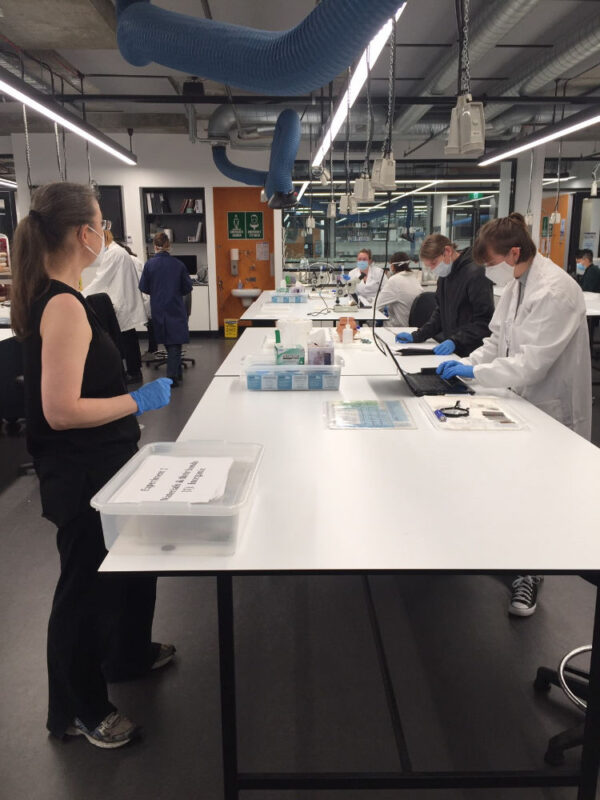
Image 1: Petronella Nel teaching the materials science based subjects and working out clever ways to interact and to keep everyone safe with social distancing in the laboratory

Image 2: Diana Tay assisting with socially distant laboratory learning
Buxton Contemporary with Katarina Paseta has hosted our first online internship for Laila Nurul Fitrani, who has also submitted her minor thesis. We congratulate minor thesis students Emma Morrison, Isabella Walker, Jackson Davies, Kathryn Drury, Lisa Mansfield, Lucy Welsh and Sandra Yee for completing their theses. We applaud and thank all of our Masters and PhD students’ positive engagement and ability to adapt.
In the research space, Nicole Tse and Asia Fellow Gea Parikesit are about to commence a successful ARC Linkage Project grant ‘3D printing of custom musical instruments for heritage and industry needs’ led by the University of Adelaide’s Professor Aaron Corn. Jonathan Kemp was a joint awardee with Toronto’s Prof. Evonne Levy of a University of Melbourne – University of Toronto grant for ‘The Technical Study of Bernini’s Bronzes: Art History, Conservation, and Material Science’. Our Master’s alumni Saiful Bakhri was awarded a 2020 Alumni Grant Scheme for a project ‘Bali Art & Heritage Conservation Internship Program #BAHCIP’ to support our graduate opportunities in Indonesia and Indonesian museum workers. Thank you also to PhD candidates Eliza O’Donnell and Claire Grech who have contributed editorial support for the next volume of the AICCM Bulletin. Both are long-standing AICCM Bulletin Editorial Assistant Committee Members.
In August, the Grimwade Centre hosted the launch of its public webinar series co-hosted with Humanities 21, The Hunter Collector: A Cultural Meander through the University of Melbourne Collections. Professor Robyn Sloggett, Associate Professor Alison Inglis, Caitlin Knight and Louise Box presented around the theme of ‘The University of Melbourne Art Collection and the Foundations of Two Academic Disciplines’. Three more monthly webinars explore some extraordinary collectors and the University of Melbourne’s prints, classics and archaeology, and Indigenous culture collection. For full details and bookings see: https://www.humanities21.com.au/whats-on.
National Gallery of Victoria
General news
The National Gallery of Victoria was closed to the public in March, and we began working remotely from 16 March. However, after the announcement of Stage 4 restrictions in Melbourne all staff transitioned to remote working and flexible work arrangements, and now Head of Conservation Michael Varcoe-Cocks is the only staff member permitted on site to perform essential tasks such as checking the gallery and back-of-house spaces for any changes.
For the NGV’s nine days of reopening, the Conservation department supported the collection changeovers ensuring all artworks are prepared for display; such as the Ai Wei Wei Chandelier overseen by object conservator Trude Ellingsen, and the construction of a double-sided frame by NGV frame-maker Jason King for the new work on paper acquisition by Francoise Gilot. Conservation was on-site for the deinstallation of KAWS and Haring Basquiat, with an object conservator onsite for Gone, as well as the dispatch of artworks from Haring-Basquiat and eventually KAWS. However, aspects of the condition reporting and couriering for the loans were completed virtually – see below image of Catherine digitally capturing these all!

Michael finished the year-long Getty Conservation Institute’s course ‘Preserving Collections in the Age of Sustainability’. An outcome of this program is a cross-departmental initiative, steered by Coordinating Conservator MaryJo Lelyveld to transition to the Bizot Green Protocol. Most exhibition galleries and storage areas at NGV-I have transitioned across to modified (soft) Bizot Green Protocol. At NGV-A, Conservation is collaborating with Facilities staff to schedule the roll-out of updating the control settings of all air-handling units (AHUs) for greater efficiency.
Treatment and research project highlights
This round of lockdown has presented its own unique set of challenges, leading to varied practical and research activities.
Senior Textiles Conservator Skye Firth and Textiles Conservator Kate Douglas have been researching the NGV quilt collection, a newly acquired quoll rug, preventive storage measures, 18th century silk linings and Regency fashion. Since working from home they’ve also been busily making storage padding and hanging forms. Textiles Display Specialist Ellen Doyle has been busy working from home constructing underpinnings for recent acquisitions with a special focus on creating corsets (see image below). She’s also made numerous dustcovers for works throughout the collection. Unfortunately, we had to farewell to Di Knight, our amazing contract Textiles Conservator, but we hope to have her back in the near future!
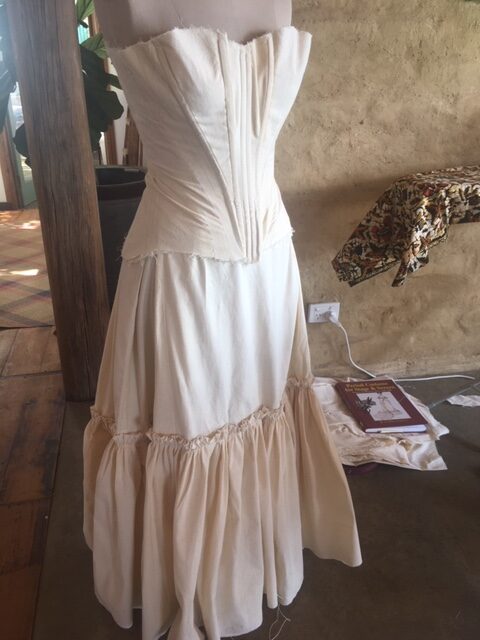
Senior Objects conservator Marika Strohschnieder has been focusing on the identification of gemstones in the NGV collection, including UV examination of known samples.
Carl Villis has written articles on his collaborative project with CSIRO to develop MS3 varnish for the Picture Restorer (UK), and with Deborah Lau for the Journal of the American Institute for Conservation.
Before Stage 4 restrictions took effect, the paintings team continued to carry out treatments. Caitlin completed work on Thomas Clark’s Upper Falls on the Wannon, and Raymonda Rajkowski cleaned Tony Tuckson’s Blue Upright. Michael Varcoe-Cocks, Raymonda and Carl teamed up to work on The Pilgrim Fathers. Raye Collins commenced work on a newly acquired painting by Constance Stokes called Portrait of a woman in a green dress, and Carl began work on Hans Gude’s After the storm, Norwegian Coast.
Since August, the painting conservation team has taken advantage of the time away from practical treatment to focus on some important NGV digital initiatives, such as providing detailed conservation entries for paintings included in the British Online catalogue, and the soon-to-follow French Online catalogue. The conservation content has been co-ordinated by Caitlin Breare and includes contributions from the whole painting conservation team.
While on-site, Jason King completed the woodworking, sanded decoration and applying the ground layers to a new reproduction frame for Arthur Streeton’s Spring. At his home workshop he has continued gilding the frame. Holly McGowan-Jackson continues research and writing about 19th century Melbourne frame makers, including an essay on the ledger/workbook of John Thallon (dated 1889/9–1903), which was transcribed by contractors Bella Lipson-Smith and Dominic King during the first shutdown in March and April. Suzi Shaw has written pieces on traditional Asian storage boxes and the investigation and treatment of a Colonial sofa for NGV Magazine and the website, and has contributed to research about clients listed in the Thallon ledger.
Before Stage 4 restrictions, Gervais Battour and Enrique Tochez-Anderson worked on rehousing a major new collection of acquisitions. This involves modifying existing frames, re-backing and glazing a large quantity of works. Gervais shared with Enrique the NGV processes that he has developed and standardised to complete this work.
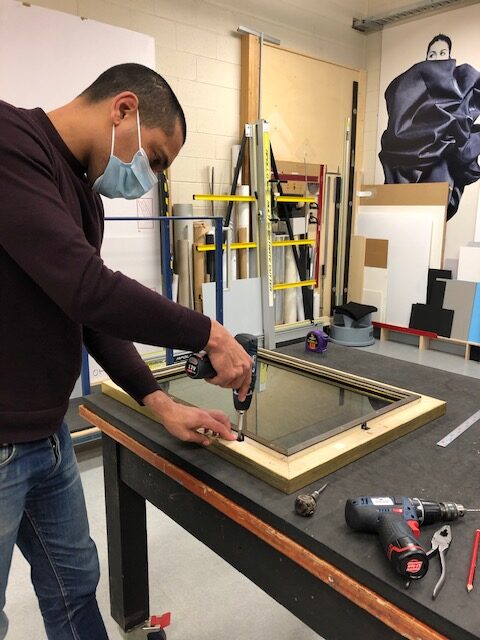
Events, outreach and online initiatives
We created an exciting new microsite, which was launched in July, with over 100 pages of conservation-related content linked!
Senior Frames and Furniture Conservator Holly McGowan-Jackson and Conservation Project Officer Jessica Lehmann contributed to new tours for reopening (now enjoyed in isolation) ‘Love & Friendship’ and ‘Her Story’ by writing new labels and recording audio tours for both tours.
Jessica has been coordinating the department’s contributions to outreach and digital engagement programs including: NGV Channel, Instagram, e-newsletters and NGV Magazine, as well as contributing to NGV Online events and media pieces as appropriate. You can read some of the most recent contributions listed below.
- Fragile beauty: emu eggs in early Australian gold and silverware – by Marika Strohschnieder
- What is in a title? Dick Watkins’s Rain in West Pymble – by Raymonda Rajkowski
- Beneath the surface: X-rays reveal a different story – by Raye Collins and Carl Villis
- ‘Unfolding’ Japanese screens – by Ruth Shervington
- A revelation: the X-ray of Herbert Badham’s Paint and morning tea (1937) – by Raye Collins
- Verso: Revealing the secret life of paintings – by Michael Varcoe-Cocks and Laurie Benson
- Picture perfect: Pictorialism and its processes – by Pip Morrison
- Susanna Highmore by Joseph Highmore: A father’s perspective – by Carl Villis
Many of us have been involved in a range of online events to the public using Webex, ranging from underpinnings and mannequins to secret Grace Crowley paintings.
Check out @ngvmelbourne Instagram for rolling Conservation department updates, including previous stories archived under the ‘Conservation’ highlights.
If you missed any of the Science Week action NGV featured on Conservators, also check out the stories archived under ‘Science Week’, and the IG live conversations with conservators are saved in the IGTV tab of Instagram as well!
In the July|Aug edition of NGV Magazine our department made unique contributions to explore including:
- Take a closer look at Constance Stokes’s Portrait of a woman in a green dress, 1930, in a video with NGV Conservator of Paintings, Raye Collins. And Raye’s essay from page 81 on the painting.
- Inside the NGV Conservation team by Conservation Project Officer Jessica Lehmann from page 97 – an exploration into three NGV conservators, highlighting the importance of women role models in STEM.
- Another Side of Grace Crowley, by Beckett Rozentals and Raye from page 87.
- Collaboration during COVID-19, a pop-out on page 109 by Coordinating Conservator MaryJo Lelyveld.
You can peruse the last 12 months of NGV Magazine issues online (FREE) here
State Library of Victoria
Since the COVID-19 crisis hit in mid-March, Collection Care at State Library Victoria has been working from home. We had a short period of a few weeks in June, where we were back on-site finishing off an annual exhibition changeover (which started in March), deinstalling exhibitions and working on various preservation projects. In July, Stage 4 restrictions hit and we were sent back home. It has been a major adjustment to our professional practice at the Library. While working at home on collection material isn’t an option, we have been involved in a number of research initiatives including: further work on modular cleaning, developing guidelines for hazardous materials in the collection, revising our collection emergency response during COVID-19 restrictions, and training Library staff on how to safely use PPE.
The Library has provided online training and improved digital access to carry out diverse and interesting projects for staff working from home including: transcribing handwritten colonial diaries from the heritage collection, updating missing metadata on digital images, and correcting imperfect OCR rendering of early Port Phillip newspapers, to name a few. Support for these projects has been provided via Zoom, Microsoft Teams and Yammer. The opportunity to get to know our collection better has been a bonus.
Our loans program continues to run during the lockdown, with the Registration team addressing new loan requests as they come in, which is heartening in these quiet times. Many of the loans were planned to go out this year, but now remain on hold for the time being.
Most significantly, we made major changes to the Library’s independent environmental monitoring. Over the last few months we have expanded our cloud-based Testo Saveris system across our on-site stores, exhibition galleries and off-site storage facilities. In the very remote corners of the Library, where the Testo system can’t reach, we have upgraded and installed a range of independent monitors. This new equipment will provide us with long-term environmental data we previously didn’t have and enable us to analyse and determine long-term environmental trends and risks across key collection areas. The Testo system provides us with live environmental data. This addition to our capability became operational just in time to assist with the response to our new working-from-home circumstances, and assist with identifying any building management issues that need addressing while we are off-site.
During Victoria’s Stage 4 COVID lockdown, only essential services are permitted on-site and access is strictly monitored by Security. Regular weekly collection checks by Preservation staff are part of critical business. In the event of a disaster we are ready to respond with the necessary work permits in place to attend to any essential service event.
Like many agencies, there has been a major shift in the Library’s digital offer during COVID-19, and time to tell our stories via social media. We can share a few here.
Blogs
Collection care working from home, blog written by Leah Williams
Cigarette cards: preservation of a small, but unique collection, blog written by Leah Williams
Stay tuned to State Library of Victoria Blogs for more.
Stories
Inside the Preservation Studio.
Behind the scenes of the magnificent Ian Potter Queen’s Hall.
Revealing the recent renovation of the original reading room of the Library
The roof. Access to views of Melbourne from the roof of the Library with CEO Kate Torney.